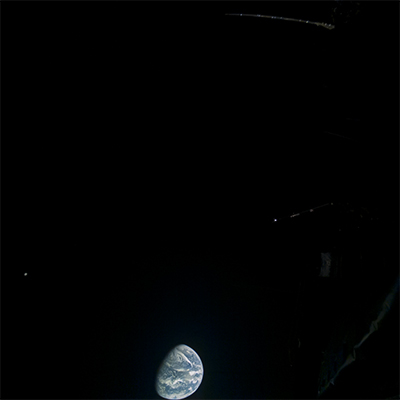Juice rerouted to Venus in world's first lunar-Earth flybyESA's Jupiter Icy Moons Explorer (Juice) has successfully completed a world-first lunar-Earth flyby, using the gravity of Earth to send it Venus-bound, on a shortcut to Jupiter through the inner Solar System.

Above: During the second step of humankind's first-ever lunar-Earth flyby, ESA's Jupiter Icy Moons Explorer (Juice) captured this stunning view of Earth. The image covers the northern Pacific Ocean. The image was taken by Juice monitoring camera 1 (JMC1) just at 23:48 CEST on 20 August 2024, as Juice was heading towards its closest approach to Earth. (ESA/Juice/JMC)
The closest approach to the Moon was at 23:15 CEST (21:15 UTC) on 19 August, guiding Juice towards a closest approach to Earth just over 24 hours later at 23:56 CEST (21:56 UTC) on 20 August.
As Juice flew just 6840 km above Southeast Asia and the Pacific Ocean, it snapped a series of images with its onboard monitoring cameras, and collected scientific data with eight of its ten instruments.
"The gravity assist flyby was flawless, everything went without a hitch, and we were thrilled to see Juice coming back so close to Earth," says Ignacio Tanco, Spacecraft Operations Manager for the mission.

Above: ESA's Jupiter Icy Moons Explorer (Juice) captured this image covering the northern Pacific Ocean, with North America starting to appear on the right (east) side of Earth. The image was taken by Juice monitoring camera 1 (JMC1) just at 00:09 CEST on 21 August 2024. (ESA/Juice/JMC)
The purpose of the flyby was to reroute Juice's path through space, using the gravity of first the Moon and then Earth to change the spacecraft's speed and direction.
The flyby of the Moon increased Juice's speed by 0.9 km/s relative to the Sun, guiding Juice towards Earth. The flyby of Earth reduced Juice's speed by 4.8 km/s relative to the Sun, guiding Juice onto a new trajectory towards Venus. Overall, the lunar-Earth flyby deflected Juice by an angle of 100° compared to its pre-flyby path.
The inherently risky flyby required ultra-precise, real-time navigation, but is saving the mission around 100–150 kg of fuel. In the month before the flyby, spacecraft operators gave Juice slight nudges to put it on exactly the right approach trajectory. Then they tracked Juice 24/7 between 17–22 August.
Thanks to a flawless Ariane 5 launch back in April 2023, Juice has a little extra propellant in its tanks to get closer to Jupiter's moon Ganymede than originally planned. The success of the lunar-Earth flyby has safeguarded this bonus science.
"Thanks to very precise navigation by ESA's Flight Dynamics team, we managed to use only a tiny fraction of the propellant reserved for this flyby. This will add to the margins we keep for a rainy day, or to extend the science mission once we get to Jupiter," adds Ignacio.
A first taste of science in space
Whilst the main goal was to alter Juice's trajectory, the lunar-Earth flyby also provided an opportunity to test out Juice's scientific instruments in space, with all ten switched on during the Moon flyby, and eight switched on during the Earth flyby.

Above: ESA's Jupiter Icy Moons Explorer (Juice) mission captured this view of the Moon. The image was taken by Juice monitoring camera 1 (JMC1) at 23:25 CEST on 19 August 2024, soon after Juice made its closest approach to the Moon. (ESA/Juice/JMC)
We expect to publish images and spectra collected by some of Juice's instruments in the next weeks, as they are downlinked from the spacecraft and evaluated by the instrument scientists. This includes high-resolution images on the Moon and Earth from Juice's scientific camera, JANUS.
"The timing and location of this double flyby allows us to thoroughly study the behaviour of Juice's instruments," explains Claire Vallat, Juice Operations Scientist.
"It happens early enough in Juice's journey that we can use the data to prepare the instruments for arrival at Jupiter. And given how well we know the physical properties of Earth, the Moon, and the surrounding space environment, it's also the ideal location to understand how the instruments respond to a real target."

Above: ESA's Jupiter Icy Moons Explorer (Juice) captured this view of Earth and the Moon. The image was taken after the flyby was complete and Juice was moving away from the Earth-Moon system. The image was taken by Juice monitoring camera 1 (JMC1) just at 02:53 CEST on 21 August 2024. (ESA/Juice/JMC)
Next step: Venus
This lunar-Earth flyby actually reduced Juice's energy, redirecting it towards a meeting with Venus in August 2025. That Venus flyby will boost Juice back out towards Earth; the spacecraft will fly by our home planet again in September 2026 and January 2029, gaining two more boosts before arrival at Jupiter in July 2031.
























